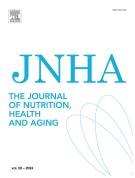Trends in underweight and severe underweight disparities in Korean adults and older adults: a nationwide, repeated cross-sectional study - 11/02/24
 , Belong Cho c, d, e, h, 1, ⁎
, Belong Cho c, d, e, h, 1, ⁎ 
Graphical abstract |
Abstract |
Objectives |
Little is known about the disparities in underweight prevalence among the general population in high-income countries. We investigated the trends in underweight prevalence and disparities across sociodemographic groups among Korean adults and older adults.
Setting and participants |
A series of cross-sectional data on Korean national health checkups for adults aged ≥20 years were analyzed from 2005 to 2016.
Measurements |
Based on body mass index (kg/m2), underweight was graded as mild (17.0–18.49), moderate (16.0–16.9), and severe (<16.0). Underweight prevalence was compared across sociodemographic subgroups in 2015–2016. Trends in underweight disparities were examined from 2005–2006 to 2015–2016. Multivariable-adjusted odds ratios (ORs; 95% confidence intervals, CIs) were calculated using logistic regression.
Results |
Approximately 11–22 million adults were included in each wave. In 2015–2016, the overall prevalence of underweight was 3.6% (men 2.0%, women 5.2%); severe underweight was 0.2% (men 0.1%, women 0.3%). The prevalence of underweight varied by sex and age groups. In men, those aged ≥80 years had the highest prevalence (overall 7.33%, severe underweight 0.84%). In women, those aged 20–29 years had the highest prevalence of overall underweight (14.57%), whereas those aged ≥80 years had the highest prevalence of severe underweight (1.38%). Compared with individuals in the lowest income quartile, men in the highest income had lower ORs of overall (0.59, 95% CI 0.59–0.60) and severe underweight (0.46, 95% CI 0.44–0.48); women in the highest income quartile had a higher OR of overall (1.12, 95% CI 1.12–1.13) but a lower OR of severe underweight (0.89, 95% CI 0.86–0.92). From 2005–2006 to 2015–2016, severe underweight consistently declined in older men but remained constant in women aged ≥80 years, widening sex disparities among older adults. Severe underweight decreased or leveled off in the highest income quartile but steadily increased in the lowest quartile, worsening income disparities.
Conclusion |
In this nationwide study, underweight was more prevalent among women, older adults aged ≥80 years, and low-income individuals. Disparities in severe underweight widened across sociodemographic subgroups over time.
Le texte complet de cet article est disponible en PDF.Keywords : Underweight, Undernutrition, Older adult, Income, Disparity
Abbreviations : BMI, CI, LMICs, OR, SES
Plan
Vol 28 - N° 4
Article 100185- avril 2024 Retour au numéroBienvenue sur EM-consulte, la référence des professionnels de santé.

